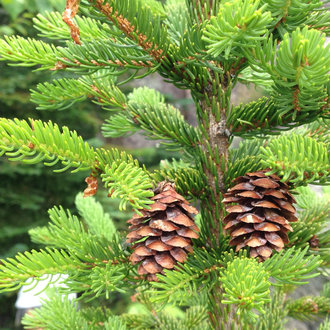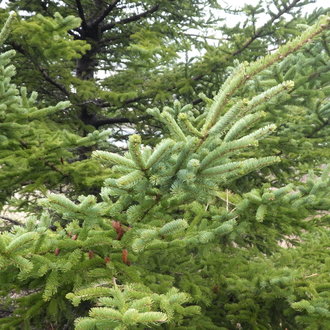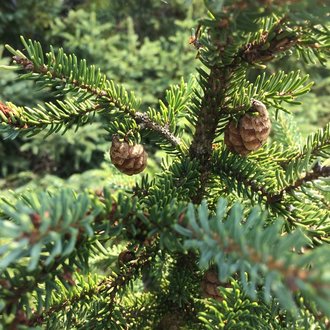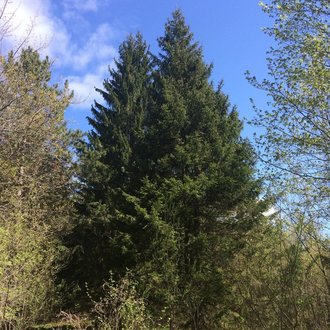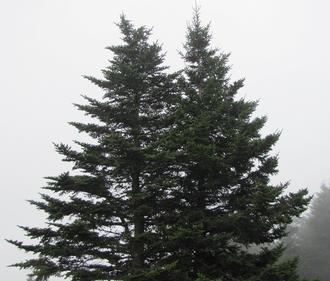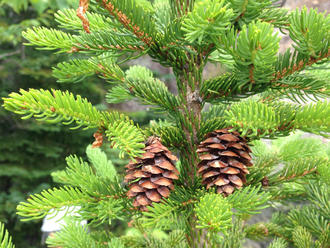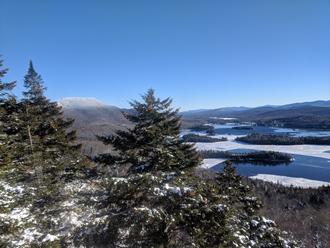Red Spruce (Picea rubens Sarg.)
↑Summary
An evergreen tree of eastern North America; the most southerly-distributed spruce of the east, found at high elevations in the south of its range.
↑Range - Expand
| Legend | Color |
| Native or Not Present | |
| Native | |
| Introduced | |
| Native or Introduced or Not Present | |
| Introduced or Not Present |
This tentative map is based on our own research. It may have limited data on Canada and/or Mexico, and there is some subjectivity in our assignment of plants as introduced vs. expanded. Read more in this blog post.
Although this plant occurs somewhere in each of these regions, it may only occur in a small part of some or all of them.
↑Description & Identification
An evergreen conifer, usually a medium-sized tree averaging 60-75 feet (18-23m) in height, the largest individuals reaching heights of 115 ft (35m.) The foliage is rich green to yellowish. Young twigs are usually densely pubescent. Trees usually have a narrowly conic shape, with horizontally spreading branches, branches and twigs held erect and not usually hanging unless weighted down by snow in winter. Buds are reddish brown in color.
The root system is very shallow, with feeding roots usually limited to the first few centimeters of soil and larger roots for anchoring usually reaching a maximum depth of only 1-2 feet.
↑Similar Plants
↑Habitat
In the south of its range, found only at high elevations where temperatures are cooler, moisture is abundant, and soils are thinner and more acidic. Found both on steep rocky slopes and exposed summits, and in wet bottomlands at high elevations, but absent from poorly-drained sites.
Inhabits a narrow range of soil pH, usually 4.0 to 5.5, and absent both from more acidic sites (especially bogs) where black spruce takes its place, and more neutral sites where it is replaced by lusher vegetation, mostly broadleaf deciduous trees.
Farther north, occurs at lower elevations as well, extending to sea level in Maine and Canada. Also found in coastal areas and on small islands and peninsulas.
Mostly found in areas that do not experience fire.
↑Life Cycle
Seedlings germinate easily but seedling mortality is high. Germination can happen in any medium, and is typically triggered by a period of high moisture. Seedlings are most likely to survive on acidic soils where competition from other plants, particularly hardwoods, is low. Seedlings have a shallow, finely-branched root system lacking both a taproot and large lateral roots; they are entirely dependent on the shallow humus in their immediate surrounding.
Trees usually start bearing cones when the tree's crown reaches direct sunlight, which is often around 15-20 years. However, in dense stands or for trees with a lot of competition, this may take much longer, and few seeds may be produced until 40-50 years of age. Seed production is light in most years, with a bumper crop at 3 to 8 year intervals.
Seeds are dispersed both by wind and rain. Most seeds are dormant through the winter and germinate in the spring, but some seeds germinate immediately after falling. Most seeds that do not germinate do not remain viable, and there is no appreciable seed banking.
Individual trees often live as long as 350 years.
↑Uses
The wood of red spruce is inexpensive and widely available, but usually knotty. Larger pieces free of knots are less available and more expensive. The wood is widely used in construction, as well as for pulpwood for paper production. It also has some more specialized uses, including as soundboards for musical instruments.
This species is rarely used in landscaping, as it tends to grow poorly in the warmer, lower-elevation regions where most human population is concentrated. In the northeast, wild trees are often found around residential development but are rarely intentionally planted.
↑Related Plants
Closely related to the native black spruce (Picea mariana), and naturally forms hybrids and integrades with it where the ranges overlap.
Also overlaps in range with the native white spruce (Picea glauca).
Two introduced spruce species, Norway spruce (Picea abies), and blue spruce (Picea pungens), did not naturally overlap with its range but have been introduced into some parts of its range.
↑Links & External Resources
• Red Spruce | The Wood Database (About This Site)
• Red Spruce | Fire Effects Information System (FEIS) (About This Site)
• Picea rubens (Red Spruce) | USDA PLANTS Database (About This Site)
• Picea rubens | Go Botany (About This Site)
• Red Spruce | Virginia Tech Dendrology Factsheets (About This Site)
• Red Spruce | Silvics of North America (About This Site)
• Picea rubens | Biota of North America Project (BONAP) (About This Site)
• Picea rubens | NatureServe Explorer (About This Site)
• Picea rubens | Flora of North America (About This Site)
• Red Spruce | Maryland Biodiversity Project (About This Site)
• Picea rubens Sargent (Red Spruce) | Digital Atlas of the Virginia Flora (About This Site)



